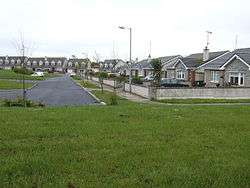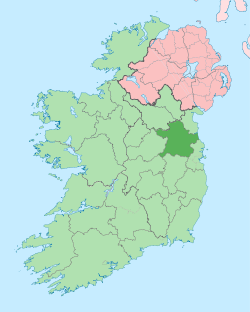Donore, County Meath
| Donore Dún Uabhair | |
|---|---|
| Town | |
 | |
 Donore Location in Ireland | |
| Coordinates: 53°41′31″N 6°24′59″W / 53.692°N 6.4165°WCoordinates: 53°41′31″N 6°24′59″W / 53.692°N 6.4165°W | |
| Country | Ireland |
| Province | Leinster |
| County | County Meath |
Donore (Irish: Dún Uabhair, meaning "Fort of pride"),[1] historically Dunower, is a small village near Drogheda in County Meath, Ireland. It lies on the Meath–Louth border in the Boyne Valley on the road between Drogheda and the Brú na Bóinne heritage site. Donore is only 2 km from the visitors' centre at Brú na Bóinne. During the late 17th century, the village was used as a defensive position by the Jacobite army of King James II against King William III during the Battle of the Boyne (1690). The Battle of the Boyne between King William III and his father-in-law, King James II, was fought on 1 July 1690 (11 July according to our modern calendar). Both kings commanded their armies in person, 36,000 on the Williamite side and 25,000 on the Jacobite side - the largest number of troops ever deployed on an Irish battlefield. At stake were the British throne, French dominance in Europe and power in Ireland. The Battle of the Boyne Visitor Centre is located in the recently restored 18th century Oldbridge House, which is on the battlesite. Free access to the battlesite, parklands and the formal gardens.
Location The Battle of the Boyne Visitor Centre is located on the South bank of the River Boyne, 3 km north of Donore Village. The site is sign-posted from Exit 9 off the M1 (Dublin/Belfast), off N51 (Slane/Drogheda) - Not Suitable for Coaches, and off N2 (Slane/Ashbourne). Coach Parking available in Visitor Centre Car Park.
Open March –April Daily 09.30-17.30 May–September Daily 10.00-18.00 Oct-Feb Daily 09.00-17.00
Last admission 1hr before closing.
Site closes Christmas and New Year. Car Park and Main Gate locked one hour after above closing times.
Admission Charges Adult: €4.00 Group/Senior: €3.00 Child/Student: €2.00 Family: €10.00 Free admission to the grounds (battlesite walkways).
Guided Tours Self Guide through Visitor Centre. Groups of 10 or more must be pre-booked Length of Tour: 1 hour Living History displays take place during the summer months. Please see www.battleoftheboyne.ie for details of dates and times of these displays.
Audiovisual Presentation Seating: 51 Duration: 15 minutes Languages: English, Irish, French, German, Italian and Spanish
Average Length of visit Visitor Centre: 1 hour approx Self Guiding Walks: 1 hour approx
The village has undergone much growth in recent years as a result of its location near the recent extension of the M1 motorway.
The village has a pub and restaurant, shops, a pharmacy, a take-away and a hairdresser.
The local gaelic football team is called St Mary's.
One of the oldest churches in Ireland, is St. Mary's Church in the center of Donore village, built between 1830 and 1850.
Public transport
Donore is served by Bus Éireann route 163 operating between Drogheda and the Brú na Bóinne Visitor Centre.[2] The nearest railway station is Drogheda railway station approximately 6 kilometres distant.
- ↑ Mills, A.D (2011). A Dictionary of British Place Names. Oxford: Oxford University Press. ISBN 9780199609086.
Donore (Dún Uabhair) Meath. ‘Fort of pride’.
- ↑ http://buseireann.ie/inner.php?id=247#Louth
| Wikimedia Commons has media related to Donore, County Meath. |
